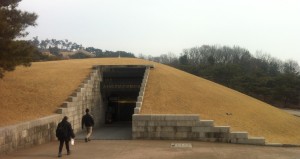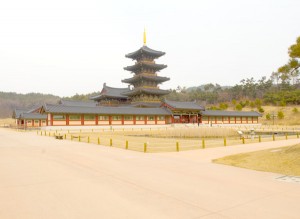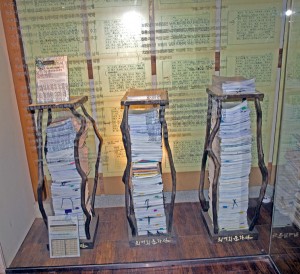 NECESSARY INTRO: Because of the blog, I was invited to take a tour of Korea by bus. It is called the K-shuttle, and it offers tours from 2 days and 1 night up to 5 days and 4 nights, and its intent is to quickly introduce a visitor to the many cultures and histories of Korea. It is awesome in several ways, not the least being it is a “hop-on”/”hop off” service, so you can stay overnight if someplace catches your fancy, and simply catch the next tour bus the next day (NOTE: You have to tell them this, of course, because they don’t run busses on days where there are no riders^^).
NECESSARY INTRO: Because of the blog, I was invited to take a tour of Korea by bus. It is called the K-shuttle, and it offers tours from 2 days and 1 night up to 5 days and 4 nights, and its intent is to quickly introduce a visitor to the many cultures and histories of Korea. It is awesome in several ways, not the least being it is a “hop-on”/”hop off” service, so you can stay overnight if someplace catches your fancy, and simply catch the next tour bus the next day (NOTE: You have to tell them this, of course, because they don’t run busses on days where there are no riders^^).
You can check out my second post here, and my third post here.
Part of the greatness of this tour is that it takes you through the Baekje, Silla, and Gogoryeo dynasty areas of Korea, giving a visitor a really great, quick, history of nearly 2000 years of Korean history prior to the complete primacy of Seoul as the center of the Korean universe.^^
My overall reactions (we went for 3 days and 2 nights) were extremely positive, and I think that if you are a short-term visitor to Korea who wants to get a sense of Korea outside of Seoul, this is the perfect way to do it. Even for my wife and I, who have travelled extensively in Korea, the tour brought us to places that we had never considered, and at least two places that we intend to re-visit as soon as the weather improves.^^ So, here, day by day… are our experiences on the K-Shuttle:
——–DAY ONE——-
Taking the K-shuttle was a strange, but good, experience for me. Part of this was because, after having lived in Korea for a long time, I had been to many of the places the tour went, so I wasn’t surprised by many of the places we visited. But in several other ways it was really great, and I can absolutely see why someone in Korea, who wanted to get outside of Seoul would take this tour and get a chance to get a much wider view of Korea. We traveled with a group from the Philippines and a group from Australia, and I managed to get them away from the tour staff and they were unanimously happy about the tour, which I think says a lot.
Also, I can’t say enough nice things about the staff – the guide was extremely well informed, super-helpful (about which more, later), and the driver was not only a good driver, but also very helpful in one instance in which I was kind of stupid.^^
The bus is fairly deluxe, but does not have a toilet, which may confound the expectations of some foreigners, but the guide was polite enough to ask, only 40 minutes into the trip, if anyone needed “10 minutes” at a rest stop, and we stopped frequently and I had the strong impression that had anyone needed a rest stop it would have happened immediately. So, once again, the friendliness of the staff was awesome. The group of us met and we headed out of Seoul on a Saturday morning early, so traffic was good.
 The first day of the tour focused on the Baekje Empire, a once massive and powerful empire that is largely forgotten today. So we headed to Buyeo. The first stop was Gongju the second capital of the Baekje empire after the Kogoryeo dynasty Baekje out of Seoul. here we had a 40 minute tour of the king Muryeong-wang burial area.
The first day of the tour focused on the Baekje Empire, a once massive and powerful empire that is largely forgotten today. So we headed to Buyeo. The first stop was Gongju the second capital of the Baekje empire after the Kogoryeo dynasty Baekje out of Seoul. here we had a 40 minute tour of the king Muryeong-wang burial area.
This had various representations of the tomb (tumuli style), of the king, and this was a great stop as the amount of time we had in the museum allowed us to look at everything and crawl into several representations of the inside of he tumulus, particularly to have a look at the very interesting brick-construction style of the tombs, which is radically different from the more well known tumuli in the Silla/Gyongju area. Like an idiot, I had not charged my camera battery, but the people at the museum were kind enough to let me use their power – this would be a theme of the day, me plugging in wherever I could find a power outlet.^^
There was certainly more that we could have looked at on the grounds, but we only had so much time. Once again, this is perfect for people in a hurry, and those who want to spend more time could just get off the bus here, do tourist things for a day, and then catch the next day’s bus.
Then it was on to Gongsanseong Fortress, which is a mountain castle was established during the Baekje Period (234-678). The castle is about 2.5km long, an while we didn’t walk the entire distance we did go through the main-gate, trek up to the remains of the castle, and walk the castle wall back down, which gave us a great view of the town. This was kind of cool, but since (as tomorrow was to bring) we were going to see a really classic fortress, I would skip it from the tour, particularly since our next stop was going to be so awesome, and could have used some more time to visit.
Lunch was a chance for all of us to introduce ourselves – as noted before we had tour groups from the Philippines, Australia, and Korea. We had various meals (we shared in order to improve the kibun^^) and headed off to Baekje Cultural Land. This place is vast, and would take at least a day to cover fully, so we went through the most important architectural square and then the out-of-Korea folks took photos in Baekje clothing.

A massive multilevel pagoda.. just to try to give a sense of scale of the place.
The area also had Woongjin Education Museum which includes information about older literature (from its website):,
“Currently displayed are 21,000 pieces in total, including 48 ancient novels, 418 textbooks, 23 Chosun era and Chinese books, 33 pieces of data related with Gongju and Chungnam, and 186 miscellaneous pieces, 52 pieces of education-related panel data, 250 pieces of data related with students/”
Here is where I saw the second use of the tour, to just kind of introduce riders to a sampler of places to visit in Korea. Yvonne and I, at least, are now planning to go back to the area and explore it more closely.This museum was in a beautiful site, surrounded by other important museums and cultural relics and.. well.. as I said, we’ll be going back.
The same shortness of time was true of our last stop, Jeonju Hanok Village, where we had time for a walk-through and to eat some Jeonju Bibimbap. This stop was a kind of teaser for a longer vacation for us (although we’ve been before), but a valuable brief introduction of a lesser-known Korean culture for the visitors from outside of Korea.
Like I said.. I’d drop that Gongsanseong Fortress stop and add more time at the museum and Jeonju Hanok Maul.
Jeonju Hanok Maul also has a relationship to Korean literature which is explained (I think I stole this from the museum’s website):
Choi Myeong-Hee was a writer who wrote just one work with all her heart and spirit for 17 years: “Honbul.” Her essay was selected for first place when she was in her third year of high school; she was widely acknowledged for her writing skills to the extent that her work was listed in a high school composition textbook. From the time when her writing won first prize in in the Jungang Daily newspaper’s literary contest in the spring of 1980 until her novel “Honbul” was published, she raised the level of Korean literature with beautiful stories of life and mind in history. Her main works are “Jeongok,” “Collapsing Light,” “Afternoon,” “Evening Bell,” and “Woman in the Neighborhood.”
And this time visiting it I was able to take pictures as I know will demonstrate by inserting one.^^

What I took to be the manuscripts for her one work, “Hanbul” (한불)
Then, an hour and a half to Kwangju, where we settled in at the Prado Hotel.
The first day was awesome, if cold, and one thing that REALLY made the tour great was that there were no forced stops to shop, and if you wanted to, you could wander away from the guide (as long as you got back to the bus on time!) and explore your own interests.
Day One was cold, but grand!


